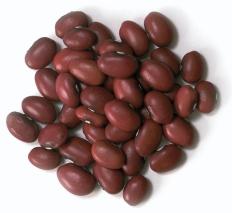
“Pulse crops” refers to a group of more than sixty different grain legume crops grown around the world. The seeds of pulse crops are important in human nutrition. They are typically made up of 20-25% protein and 40-50% starch; they are also rich in dietary fibre and usually have only small amounts of oil. The protein of pulse seeds is high in the amino acids lysine and methionine, making pulses nutritionally complementary to cereals, which are deficient in these two essential amino acids. Pulses are the main source of protein in the diet of vegetarians, and feature prominently in the traditional cuisine of virtually every region of the globe. Seeds and pods of many pulse crops are also used as fresh vegetables when the seeds are still tender. Pulses are mainly consumed as human food, but some crops such as field pea and faba bean are also used in animal feeds as a source of protein and starch. Pulses are usually consumed in the form of soup or stew, cooked directly from the whole or split dry seeds, or in canned form in some countries. Most pulses, but especially chickpea, are also prepared as flour.
The five most important global pulse crops are common bean, field pea, chickpea, lentil, and faba bean. All five are grown in Saskatchewan. Pulse crops are valuable as an annual legume in crop rotations because they provide breaks in disease cycles that affect the major cereal and oilseed crops. They also provide a diversified source of farm income. An important feature of pulse crops, as of other legumes, is their ability to fix nitrogen from the atmosphere in association with bacteria known as Rhizobia, thereby reducing the requirement for nitrogen fertilizer.
Historical records of farms and research stations in Saskatchewan from 1900 to 1950 show that some pioneering farmers produced beans and peas. The modern pulse industry started in the 1960s, when farmers began producing and exporting field peas and lentils. During the 1970s the industry grew slowly but steadily, building on progress in research and development in agronomy and plant breeding, especially for lentil, field pea and faba bean. In the 1980s the industry began a dramatic expansion in response to international market demand from pulse importers in countries where cereal and oilseeds crops had begun to replace pulse crop production. In Saskatchewan, many small pulse processing companies were established to meet the demand for cleaning and exporting increasing amounts of bulk and container pulses, especially large green lentils, green peas and yellow peas. In the 1990s Saskatchewan added chickpea and dry bean to the list of pulse crop exports. By 2001, pulse crops were grown on about six million acres, representing over 11% of the cropland in the province.
Saskatchewan pulses are currently exported to more than 130 countries around the world. Over the past thirty years, the province’s pulse industry has become one of the major global suppliers of lentil and field pea. Saskatchewan now has more than 100 pulse exporting companies dedicated to shipping bulk or containers to almost every pulse importing country worldwide; on a global scale, it is now the largest exporter of lentil and field pea. By 2003, at least ten companies were active in the business of dehulling and splitting peas, lentils and chickpeas for domestic and overseas markets. Other associated industries that have expanded, complementing the growth of the pulse crop industry, are specialized farm equipment manufacturing, the Rhizobium inoculant industry, agricultural chemicals, and the organic pulse crop industry.
Each crop sector within the pulse industry produces a diverse range of products that changes in response to market demand. The lentil crop originally consisted of green lentils of various sizes, but since 1996 the red lentil crop has been expanding. Shipments of French green lentils are exported to Europe each year. Most of the field pea crop is the yellow type, grown for either human food or animal feed. Green peas are grown for human consumption; and small amounts of other types such as marrowfat for snack foods, maple types for bird feed, and small-seeded forage types are also grown. Saskatchewan produces both kabuli (large white-seeded) and desi (small brown-seeded) chickpeas. The other pulse crops, such as common bean and faba bean, are grown in smaller quantities. Most dry bean production is pinto or black bean. Small amounts of medium-sized faba bean are grown each year for consumption in Mediterranean markets.
The pulse industry has become a significant part of the Saskatchewan agricultural economy, providing both full-time and seasonal employment in the farm input, grain processing, and transportation sectors. It is a vital and growing segment of Saskatchewan agriculture.
Albert Vandenberg